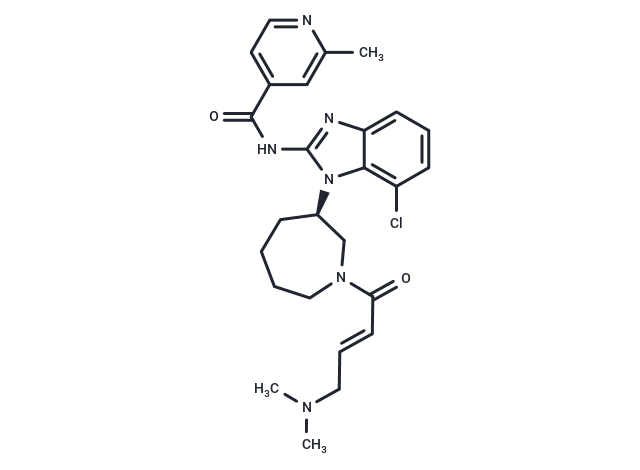Shopping Cart
- Remove All
 Your shopping cart is currently empty
Your shopping cart is currently empty


| Pack Size | Price | Availability | Quantity |
|---|---|---|---|
| 5 mg | $43 | In Stock | |
| 10 mg | $73 | In Stock | |
| 25 mg | $118 | In Stock | |
| 50 mg | $223 | In Stock | |
| 100 mg | $333 | In Stock | |
| 200 mg | $478 | In Stock | |
| 1 mL x 10 mM (in DMSO) | $47 | In Stock |
| Description | Nazartinib (EGF816) (EGF816, NVS-816) is a covalent, irreversible, mutant-selective EGFR inhibitor that has nanomolar inhibitory potency against activating mt (L858R, ex19del) and T790M mt, with up to 60-fold selectivity over wild type (wt) EGFR in vitro. |
| Targets&IC50 | EGFR (mutant):0.031 μM(Ki) |
| In vitro | Nazartinib is a novel, covalent, mutant-selective EGFR inhibitor with nearly equipotent activity on both oncogenic (L858R and ex19del) and T790M-resistant mutations and good selectivity over WT EGFR. Nazartinib potently inhibits the most common EGFR mutations L858R, Ex19del, and T790M in vitro. The cellular activity of Nazartinib on EGFR mutants are assessed using three well-characterized cell lines, H3255, HCC827, and H1975, which harbor the L858R, Ex19del, and L858R/T790M mutations, respectively. After incubation with cells for 3 hours, Nazartinib shows potent inhibition of pEGFR levels in H3255, HCC827, and H1975 with EC50 values of 5, 1, and 3 nmol/L, respectively. Cellular-based assays shows that Nazartinib is selective toward mutant over WT EGFR. |
| In vivo | Nazartinib is well tolerated and possesses favorable physicochemical properties and good oral bioavailability in mice. It shows moderate volume of distribution and low to moderate clearance in rodents (30% and 35% of rat and mouse liver blood flow, respectively). In the dog, Nazartinib shows high clearance and high volume of distribution. Nazartinib also demonstrates antitumor activity in an exon 20 insertion mutant model. At levels above efficacious doses, Nazartinib treatment leads to minimal inhibition of WT EGFR and is well tolerated. In single-dose studies, Nazartinib provides sustained inhibition of EGFR phosphorylation, consistent with its ability for irreversible binding. Nazartinib has a longer half-life in human than mouse and is currently being evaluated in phase I/II Clinicalal trials in patients harboring EGFR mutations, including T790M. |
| Kinase Assay | Recombinant kinase domain of EGFR L858R and T790M-L858R mutants are incubated with EGF816 to confirm covalent modification of EGFR and site of adduction. Recombinant enzyme is incubated at room temperature with a 20-fold molar excess of compound in 40 mM Tris, pH 8, 500 mM NaCl, 1% glycerol, 5 mM TCEP for 1 h. The reaction is quenched by addition of dithiothreitol (DTT, 80-fold excess to compound) and transfer to ice. A third of the reaction (10 μL) is processed for intact MS by adding an equal volume of 6 M Guan HCl, 100 mM Tris, pH 8, 20 mM DTT, 10 mM TCEP and incubating at room temperature for 15 min. Intact MS analysis is performed on an Agilent 6520 QToF mass spectrometer equipped with a dual spray ion source (IS of 4500 V, fragmentor of 250 V, fas temp of 350°C, and skimmer of 75 V). The samples are injected onto a PLRP-S column (2.1 mm × 50 mm), heated to 60°C, and desalted for 2 min at 500 μL/min and 3% B prior to elution with a fast gradient of 3-50% B in 3 min (B, 0.1% formic acid). The data are analyzed in MassHunter for automatic peak selection, integration, and spectral deconvolution with a mass range of 15?000-75?000 Da. |
| Cell Research | H1975, H3255, HCC827, A431, and HaCaT cells are maintained in RPMI media supplemented with antibiotics and 10% FBS, maintained in a 37°C, 5% CO2 humidified incubator. After an overnight incubation in 384-well plates, serial diluted compounds are transferred to cells and incubated for 3 hours. HaCaT cells are stimulated with 10 ng/mL EGF (50 ng/mL EGF for A431) for 5 minutes. Cells are lysed in 1% Triton X-100 buffer containing protease and phosphatase inhibitors. Lysates are analyzed by sandwich ELISA utilizing goat anti-EGFR capture antibody, anti-phospho-EGFR(Y1173), and anti-rabbit HRP. Signal is measured by chemiluminescent detection.(Only for Reference) |
| Alias | EGF816, NVS-816 |
| Molecular Weight | 495.02 |
| Formula | C26H31ClN6O2 |
| Cas No. | 1508250-71-2 |
| Storage | Powder: -20°C for 3 years | In solvent: -80°C for 1 year | Shipping with blue ice. | |||||||||||||||||||||||||||||||||||
| Solubility Information | Ethanol: 92 mg/mL (185.9 mM) DMSO: 92 mg/mL (185.9 mM) H2O: < 1 mg/mL (insoluble or slightly soluble) | |||||||||||||||||||||||||||||||||||
Solution Preparation Table | ||||||||||||||||||||||||||||||||||||
Ethanol/DMSO
| ||||||||||||||||||||||||||||||||||||

Copyright © 2015-2024 TargetMol Chemicals Inc. All Rights Reserved.